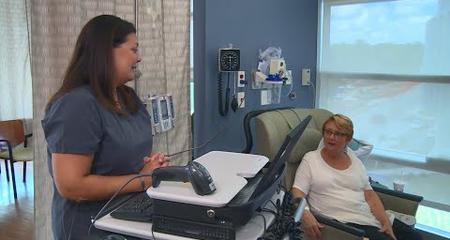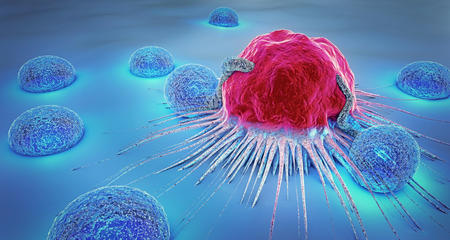The pharynx is a hollow “tube” that starts behind the nose and ends where the esophagus begins.The oropharynx is the middle part of this structure. It is located behind the mouth and includes the back part of the tongue (tongue base), soft palate, tonsils, and side and back walls of throat.
- Traditionally these cancers have been closely linked with tobacco and alcohol use.
- More recently, the majority of patients are diagnosed with disease associated with a common virus known as human papillomavirus (HPV). HPV-related cancers tend to present in younger patients and have a more favorable prognosis with standard treatment. Because of their favorable prognosis, on-going efforts are aimed at deintensifying therapy with the goal of reducing treatment-related side effects.
- Our head and neck cancer team is dedicated to achieving the best cancer outcomes while limiting side effects whenever possible.
- We offer cutting-edge options in surgery, radiation therapy and chemotherapy. Every patient we see also has access to clinical trials aimed at improved treatment success and quality of life.
Risk Factors
- Human papillomavirus (HPV)
- Tobacco use
- Heavy alcohol use
Symptoms
Individuals with oropharyngeal cancer may not have any symptoms. If symptoms do occur, they may include:
- Neck lump or mass
- Sore throat
- Pain or difficulty swallowing
- Ear pain (often limited to one side)
- Sensation that something is “stuck” in your throat (also known as “globus sensation”)
- Trouble opening your mouth or moving your tongue
- Blood in saliva
- Muffled voice
Diagnosis
As part of the initial visit, the following tests may be used to detect, diagnose and/or stage a laryngeal or hypopharygeal cancer.
- Physical Examination
- Endoscopy: a flexible scope placed through your nose (to avoid the gag reflex) to visualize the voice box
- Imaging: May include ultrasound, CT scan, MRI and/or a PET scan
- Biopsy
- Fine needle aspiration (FNA) of neck mass — often done in the clinic
- Sampling of primary tumor site — can be done in the clinic or may require an exam under anesthesia in the operating room
- Sampling of the suspicious lesion/mass to definitively diagnose the type of tumor, often required to be done in the operating room with an outpatient procedure.
Treatment
Treatment paradigms for oropharynx cancer are rapidly evolving. therefore, management is individualized to each patient based on preference and disease presentation.
Treatment options may involve surgery, radiation therapy, chemotherapy or a combination of these. Significant advances in surgical techniques and tools allow surgeons to remove tumors in difficult locations in a minimally invasive fashion.
Similar technological improvements in radiation therapy allow better targeting of tumors while reducing negative impact to surrounding normal tissues.
In addition to traditional chemotherapy, there is an increasing role for the use of many newer targeted agents.
Patients treated at the Froedtert & MCW Clinical Cancer Center at Froedtert Hospital have access to these advanced treatments and techniques offered by specialists who are highly trained in treating head and neck cancers. This allows patients to achieve excellent oncologic outcomes while preserving as much quality of life as possible.
Our patients have access to all of the latest technology in treatment options for HPV oropharyngeal cancer. Each patient is involved in a tailor-made treatment program to fit his or her unique needs. Our multidisciplinary team approach means each patient’s care team includes all of the physician and other experts needed to chart the most successful treatment possible — to fight cancer and preserve function and speech. Treatment options often include:
- Chemotherapy regimens that minimize side effects.
- Minimally invasive surgical techniques, including robotic and laser surgery, performed through the mouth to help reduce damage to surrounding tissue.
To help bring patients the latest options in cancer-fighting treatments and drugs, our head and neck cancer specialists are members of several research consortiums, offering unparalleled access to clinical trials.
HPV and Oropharyngeal Cancer - Video FAQ
Jennifer Bruening, MD, surgical oncologist, talks about oropharyngeal cancer.
Oropharyngeal cancer is a type of throat cancer that affects the back of the mouth. It can include your tonsils or your soft palate, the back side of your tongue or the very back of your throat behind your tonsils.
Jennifer Bruening, MD, surgical oncologist, talks about the leading causes of oropharyngeal cancer.
The most common type of cancer that occurs in the oropharynx is squamous cell carcinoma. Historically, the leading cause of oropharyngeal cancer was tobacco and alcohol use.
Today, however, the leading cause is human papilloma virus (HPV). HPV causes other cancers, such as cervical cancer. Other types of cancers that can occur in this area include lymphoma, salivary gland cancers and other rare cancers, like sarcomas.
Jennifer Bruening, MD, surgical oncologist, explains oropharyngeal cancer can develop and become noticeable within months and lists early-stage and more advanced symptoms including pain and problems with swallowing and breathing.
It can take months for an oropharyngeal cancer to develop and become noticed and diagnosed. Early stage cancers usually present with a neck mass, but can sometimes have throat pain or ear pain or unexplained weight loss.
With larger, more advanced tumors, patients usually have sore throat and can have difficulty swallowing or breathing.
Jennifer Bruening, MD, surgical oncologist, explains oropharyngeal cancers treatment outcomes.
Oropharyngeal cancer is curable. HPV-related oropharyngeal cancers have a much better prognosis and the five-year survival rate is upward of 85%. HPV-negative tumors do not respond as well to treatment and can have much poorer outcomes with a survival rate of around 30% for very advanced tumors.
Jennifer Bruening, MD, surgical oncologist, describes various oropharyngeal cancer treatments, including surgery, radiation, chemotherapy and immunotherapy. Early-stage tumors can be removed with minimally invasive techniques, while advanced tumors require more extensive treatment.
Oropharyngeal cancer treatment can include surgery, radiation, chemotherapy or immunotherapy (the newest technique). Early-stage oropharyngeal cancers can be treated with surgery or radiation alone.
More advanced cancers usually require a combination of treatments, including surgery plus radiation or radiation plus chemotherapy. In very advanced tumors, some patients need all three — surgery, radiation and chemotherapy.
Surgery usually involves removing the cancer from the throat. Early-stage tumors can be removed with minimally invasive techniques, such as using endoscopes, microscopes or a special robot in a technique called transoral robotic surgery (TORS).
More advanced tumors might require us to remove the tumor through the neck and often require us to remove the lymph nodes of the neck as well. The lymph nodes are the first location these tumors tend to spread to. That procedure is called a neck dissection or lymph node dissection.
Jennifer Bruening, MD, surgical oncologist, explains the different survival rates for HPV-related and HPV-negative oropharyngeal cancers.
The survival rate for oropharyngeal cancer depends on the type of cancer. If it is one of the HPV-related cancers, these patients tend to do very well, and survival can be above 85% at five years.
In HPV-negative cancers, these patients do not respond as well to treatment. Very advanced tumors can have survival at five years around 30%.
Survival statistics are based on a large number of patients to obtain an average survival compared to the normal population. Keep in mind that each patient is different and can exceed or go below the predicted survival outcome.
Stuart Wong, MD, medical oncologist, explains human papillomavirus (HPV): what it is, who has been exposed and how the virus is spread.
Human papillomavirus (HPV) is a virus that is actually omnipresent. It is estimated that 80% of the U.S. population has been exposed to the virus and has evidence of exposure in the blood. There are documented occurrences where the virus can be spread through household contact, although we typically associate the virus being related to causing cancer in relationship to sexual transmission.
Stuart Wong, MD, medical oncologist, explains human papillomavirus (HPV) associated cancers that may result from the virus.
HPV is associated with a number of different cancers, including cervical cancer anal canal cancer — in addition to HPV-associated cancer in the throat. The HPV vaccine is exceedingly effective in preventing HPV-associated cancers, although this is dependent on making sure one takes the full set of vaccination, which would be two doses for young teens or the the full three-set for older teens and adults.
Stuart Wong, MD, medical oncologist, describes the symptoms that are commonly associated with human papillomavirus (HPV) cancers.
The most common symptoms of HPV-associated cancers are pain in the throat or swelling in the neck. The most important aspect is the persistence of those symptoms.
It is quite common for patients to have a sore throat or swollen glands. These are commonly associated with head colds. If you have these symptoms, and they persist or come and go, that is a sign that you should see your primary care physician.
HPV-associated cancers are frequently hidden, so you may not see anything in your mouth or your throat. They are often associated with swelling in the neck that one might notice when you are shaving, and you actually might feel a lump in your neck. In the mouth or throat, sometimes you may see a swelling in your tonsils or a swollen area in your tongue. It's the hidden symptoms that are probably most common, rather than what you would see in the mirror.
Stuart Wong, MD, medical oncologist, explains human papillomavirus (HPV) as a virus and that cancers related to it often happen later in life.
There is evidence that HPV-associated cancers happen in what we call a bimodal distribution — an earlier stage in the 50s and then another peak in the 70s. This may be associated with a rise in incidence of the infection happening early in the life and then in midlife.
Stuart Wong, MD, medical oncologist, explains that HPV-related cancers require a team of head and neck cancer specialists for the most effective treatment and control of related side effects and symptoms.
The treatment for HPV-associated cancers typically is what we call multi-modality therapy. There are some instances where the cancer could be cured with just a single modality — such as surgery or radiation. For the most part, though, these are cancers that require a team of specialists. Here at the Froedtert & MCW health network, we are committed to providing multi-disciplinary care — which is not just the cancer treatment, but treatment for the related side effects and symptoms
Stuart Wong, MD, medical oncologist, explains the treatment of cancers associated with human papillomavirus (HPV).
HPV-associated cancers typically wax and wane, so that they can have more symptoms, then calm down and then get worse. Frequently, a primary care physician might try a course of antibiotics, and this may temporarily improve symptoms, but the cancer itself will never go away. In order to make the cancer go away, you need definitive treatment with a cancer specialist.
Stuart Wong, MD, medical oncologist, explains why human papillomavirus (HPV) associated cancers have a high cure rate.
HPV-associated cancers have a high curability rate because these cancers have a very specific cause associated with the virus. That means that they are frequently easy to kill off, but this requires a team approach.
We have surgeons and radiation oncologists and medical oncologists who all team together to treat these cancers. Fortunately, if these cancers are diagnosed early, the likelihood of cure is quite good. And even for those patients with very advanced cancers or where the cancer has spread or come back elsewhere in the body, these cancers typically have a more favorable prognosis — especially with the newer therapies that we have.
Stuart Wong, MD, medical oncologist, talks about Gardasil®, the vaccine used to prevent the human papillomavirus (HPV).
The Gardasil vaccine has been shown to be very effective, as well as safe. It has approval by the FDA for children starting as young as nine and has minimal side effects. There may be typical side effects of swelling or redness at the injection site, but very few — if any — serious side effects.
Stuart Wong, MD, medical oncologist, explains when to get vaccinated for human papillomavirus (HPV).
Once a patient is exposed to the HPV virus, vaccination has not been shown to be effective. The best use of vaccination is for young individuals before they have a chance for exposure to the HPV virus.
Virtual Visits Are Available
Safe and convenient virtual visits by video let you get the care you need via a mobile device, tablet or computer wherever you are. We’ll gather your medical records for you and get our experts’ input so we can offer treatment options without an in-person visit. To schedule a virtual visit, call 1-866-680-0505.
Recognized as High Performing by U.S. News & World Report
Froedtert Hospital is recognized by U.S. News & World Report as high performing in three adult specialties and 16 procedures and conditions, including cancer.
More to Explore





